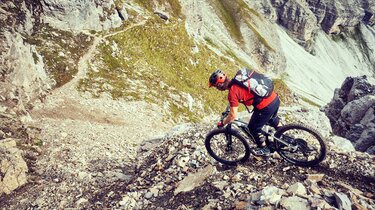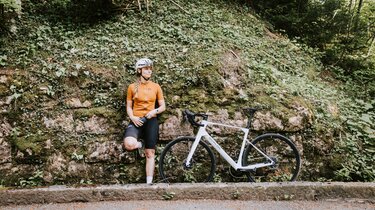

Developer Yannick talks about the Rapcon
What does the development process of bikes like the Rapcon look like, and what makes this mountain bike stand out? Read the interview with Yannick!
The history of the Rapcon from its developer’s point of view
Higher stack for a relaxed sitting position in steep sections and a better angle of attack for the rear triangle. Longer chainstays ensure that you always have enough grip on the front wheel without having to overload it. They also ensure a permanently central and ready-to-move position. And a flat but not extreme steering angle for an optimal mix of trail stability and grip. Anyone who has ever ridden a SIMPLON Rapcon will appreciate the optimally balanced geometry.
But what does the development process of a bike like this actually look like? In the interview, developer Yannick speaks from the toolbox. He tells us which steps are necessary and what makes the geometry of the Rapcon stand out. He also talks about the idea for the Rapcon video and grants us a quick look into the future.
How long have you been with SIMPLON, and what do you like about your job?
I have been with SIMPLON since 2017. My day-to-day work is very varied. Being a developer allows me to be creative and showcase my design skills. The Rapcon Pmax was the first time I was involved in the development of a complete bike. With the current version of the Rapcon, we have achieved another masterpiece of which we are very proud.
Did you take current trends into account during the development process? If so, what were they?
Trends always need to be taken into account. But it is even more important for us to take a pioneering role ourselves because that way, we can stand out from the crowd. Since our developments take several years, it is also important to critically question new trends. After all, the bicycle industry is a fast-moving sector, and what is still the state of the art today may already be obsolete tomorrow.
We always take into account the wishes and requirements of our community as well as our own intuitions. In the case of the Rapcon , it was important to us to create an enduro bike with modern but not too extreme geometry. For a while, it seemed that longer bikes were basically better and that the reach also had to grow significantly. The Rapcon has also become longer compared to its predecessor, but we have limited ourselves to a dimension that still integrates the rider into the bike, keeping them agile and ready to move.
In combination with the growing chainstays and the size-specific kinematics, the current model is a pioneer in terms of balanced handling. In our opinion, this is what matters in an enduro or trail bike. Riders are in control of the bike at all times and feel safe as a result.
Please tell us what steps are part of the development process of a SIMPLON bike such as the Rapcon.
Every project starts with defining the goal. It serves as an important guide throughout the process. To define a goal, we ask ourselves questions like: For which person are we designing this bike? On what terrain will the bike be used?
The result of answering these questions is the concept of the bike. Based on this, we consider the requirements for the geometry and the rear triangle of the bike.
The next step is the design process. In many iterations, ideas about the appearance, technical specifications and other ideas are brought together and combined in different ways. The design created on the computer is then discussed with our suppliers. What follows are further inputs for the production and additional details that entail corresponding adjustments.
If the design works well in theory, a 3D-printed frame is produced. All the components that we want to use on the finished bike are installed on this frame. The advantage: This makes it easier to estimate clearances, and we can also check the design once again. Individual parts of the frame are usually printed during development to determine whether the design can be implemented as planned.
Then it’s time to make the mould. After numerous bench tests of the prototype frames, the first rideable prototype is produced. Of course, we put this one through its paces. Every single part and its riding behaviour on the respective terrain are checked. Adaptations that can occur in this phase are, for instance, adjustments to the carbon layup or the shape of individual parts.
Only when all the bicycle components are perfectly matched to each other does the final production of a small series take place.
When did you hold the prototype in your hands, or when was your first ride? And what did that feel like?
The first rideable prototype was ready in December 2020. It was cold outside, and the local trails were already covered with 15 centimetres of snow. That’s why I did the first lap in our assembly hall. I immediately had a good feeling, which is why I ventured off-road despite the snowy conditions. The trails in our area are mostly steep hiking trails that are very demanding even when dry.
On the Rapcon, I felt safe from the first moment. The bike was well-balanced and easy-going, so I felt in control at all times, despite the snow.
Do you want to read a detailed test report on the Rapcon ? Our colleague Jörg told us how he felt on his first ride.
What criteria did you use to decide on the geometry, technology, shapes and colours?
When it comes to the bike’s geometry, it needs to align with the respective terrain of use. We also attach great importance to balanced riding behaviour, as this increases the rider’s self-confidence. When it comes to the technical features, we make sure that they integrate harmoniously into the design of the bike.
In addition to the technology, the bike’s appearance also plays a key role, of course. After all, you can build the best bike from a technical standpoint – if it doesn’t look good, hardly anyone will buy it. There are some design rules that you can follow but, in the end, it’s all a matter of preference, so there is no right or wrong.
Choosing the colour is a special challenge, as every rider’s taste is unique. At SIMPLON, we like to go for classic colours. We prefer rather timeless tones. After all, a SIMPLON bike is a cost-intensive purchase, and riders will have it for a long time. If you choose a trendy colour, you might get tired of it just a short time later.
How many people are involved in the development process and in which steps?
Quite a few. In reality, the entire company and the suppliers. First, the project has to be initiated. The decision-makers are especially involved in this phase. Then the development team gets the order. Currently, there are six of us who work intensively on projects during this phase. When it comes to transitioning a bike to serial production, the assembly department prepares everything.
How long does it take to go from development to the finished bike?
From the decision to develop a new bike to presenting it to the first customers, it’s usually about two years.
How can you test whether the bike is “good” or meets the requirements?
First, the frame gets tested on the test bench to make sure that it is strong enough and that there is no risk to health when riding it. We also collaborate closely with the EFBE testing institute to test our frames for durability in a standardised way.
Yet, bench tests alone are not enough. As soon as we receive the first rideable frame, we complete intensive test rides in the respective terrain of use. This is the only way we can identify any weak points and optimise the handling of the bike. By adjusting the layup, for instance, the stiffness of individual parts can be increased or decreased.
During the ride, you may also notice that your shoes keep rubbing against the chainstay. In this case, the shape or the course of the chainstay can be optimised to make sure that customers end up with the perfect bike.
Who else tests the bike besides you?
Aside from me, the SIMPLON test committee includes the other members of the development team and special riders for the respective terrain of use.
How does SIMPLON make its bikes stand out from the crowd?
We try to offer features on every bike that are unique on the market. These can be special equipment details or technical features, the weight or the handling. At SIMPLON, we live and breathe the topic of bikes every day, and that’s what makes us stand out. We are only satisfied when we have found the best solution from our point of view.
What geometry did you choose for the bike, and what were the reasons for choosing this one?
In recent years, the geometries of bicycles have evolved a lot. The trend has been towards longer and longer bikes that are also flatter by one degree, or better yet, two degrees.
When we developed the Rapcon, however, our aim was not to build the longest model on the market. We even made the bike shorter than planned in the course of development in order to achieve the riding characteristics we wanted. We also asked ourselves: How can we make the bike better without going to extremes? The Rapcon was designed to do well in every situation, be easy to handle and offer maximum safety.
To achieve this, we focused on balance. The result: improved running smoothness, better grip, a more relaxed, yet agile riding position and increased safety.
The central feature of a balanced geometry is the size-specific and moderately dimensioned chainstay length (XI geometry). It allows for optimal wheel load distribution for every frame size and opens the door to further adjustments.
The slightly longer chainstays allowed us to increase the stack without losing pressure on the front wheel, which is largely responsible for the front wheel’s grip. This in turn has a positive effect on the riding behaviour in steep terrain, which conveys safety and helps riders conserve energy thanks to the more relaxed riding position.
The moderately long reach keeps you in control at all times, and the agile handling allows you to react quickly to all the challenges of the trail. The short seat tubes also give the rider enough room for any manoeuvre.
SIMPLON recently released a video about the Rapcon. How did the idea for it come about?
The project “Developing a Rapcon without a motor” has been around for a while. We dealt intensively with the question of whether bikes without drive unit could still be sold at all. There was also talk about focusing only on e-bikes.
In the video, this situation is supposed to be a nightmare scenario – but in the end, it turns out to be a good thing. Personally, I like to switch between natural and electric drive, and I’m glad that we at SIMPLON have both options in our repertoire.
Do you think there will only be bikes with a motor soon?
We’ll see what the future holds. The bicycle industry is constantly evolving and always good for surprises. So let’s just stay curious about how the market develops.
Would you like to know what our SIMPLON CEO Stefan Vollbach has to say about the future of the brand? In our latest news update , he talks about the direction things will take.
On your marks, get set, configure!
Now it’s your turn: In our configurator, you can configure the Rapcon to your individual preferences.















